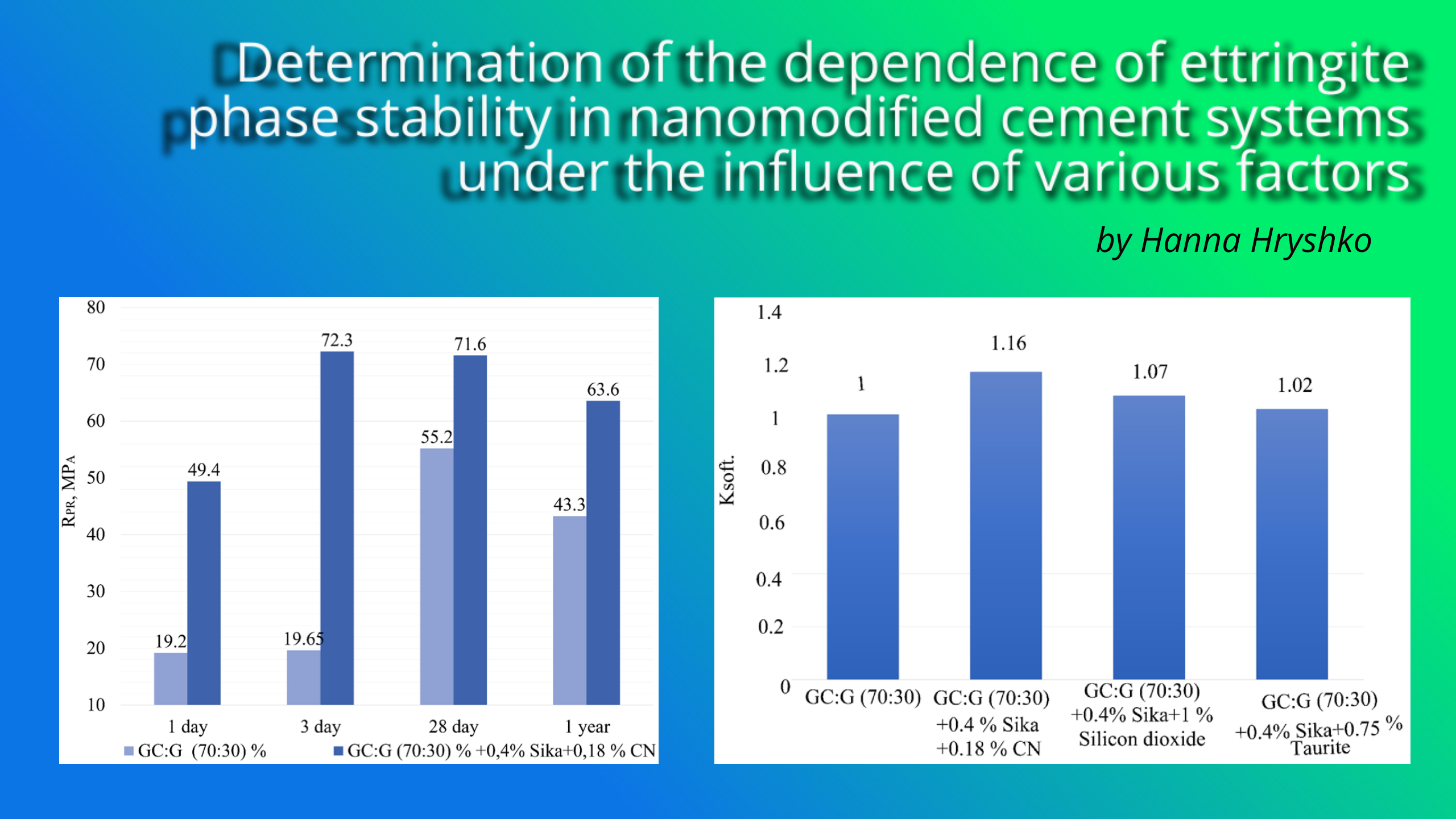Визначення залежності стабільності етрингітової фази наномодифікованих цементних систем в умовах дії різних факторів
DOI:
https://doi.org/10.15587/2706-5448.2025.323965Ключові слова:
в'яжуче, розчин, етрингіт, стабілізація етрингіту, алюмінатні цементи, сульфоалюмінатні цементиАнотація
Об'єктом дослідження є стабілізація етрингітової фази в цементних системах, що містять гіпсоглиноземистий цемент та наночастки. Одним з найбільш проблемних місць є нестабільність етрингітової фази, що впливає на довговічність і механічні характеристики матеріалів. Основні проблеми полягають у недостатньому врахуванні переходів між макро-, мікро- та нанорівнями при формуванні структури тверднучої системи. По існуючим моделям не можна розраховувати багатокомпонентні суміші, оскільки не враховується значна кількість першопочаткових параметрів та характеристик. Не враховується перехід систем з одного рівня на інший, а саме перехід систем з макро- в мікро- і на нанорівень. В ході дослідження використовувалися наномодифікація цементних систем на основі гіпсоглиноземистого цементу шляхом введення до твердючої матриці синтизованих композитів (вуглецеві наночастинки). Досліджено вплив компонентів сировинної суміші на виправлення чинників нестабільності етрингітової фази, процеси структуроутворення, що дозволяє в перспективі усунути дані недоліки та управляти структуроутворенням на різних рівнях твердючої системи-матриці. Отримано оптимальну величину сульфату кальцію для утворення етрингіту – 30–40 % від маси композиції. Це пов'язано з тим, що запропонований склад ГЦ-40/Г – 70/30 % має значну кількість гідроалюмінатів кальцію в процесі гідратації, міцність на стиск і згин становить, відповідно, 14 і 10 МПа. Зокрема, утворюється стійке до розшарування дисперсне середовище, водовиділення якого стабілізується протягом 3 год. Отримання таких значень забезпечується завдяки тому, що етрингіт утворюється в перші терміни твердіння та з високою швидкістю забезпечує ріст міцності каменю. У порівнянні з аналогічними відомими гіпсоглиноземистими цементами це забезпечує переваги при формуванні високоосновного етрингіту. Отримані результати рекомендується використовувати при зведенні тунелів, відновленні гідротехнічних споруд та транспортної інфраструктури.
Посилання
- Gołaszewski, J., Gołaszewska, M. (2021). Properties of mortars with Calcium Sulfoaluminate cements with the addition of Portland cement and limestone. Archives of Civil Engineering, 67 (2), 425–435. https://doi.org/10.24425/ace.2021.137177
- Yanze, G. A. N., Nana, A., Lemougna, P. N., Kaze, R. C., Tome, S., Rahier, H. et al. (2024). Development of calcium sulfoaluminate cements from rich‐alumina bauxite and marble wastes: Physicochemical and microstructural characterization. International Journal of Ceramic Engineering & Science, 6 (3). https://doi.org/10.1002/ces2.10216
- Godinho, J. P., De Souza Júnior, T. F., Medeiros, M. H. F., Silva, M. S. A. (2020). Factors influencing ultrasonic pulse velocity in concrete. Revista IBRACON de Estruturas e Materiais, 13 (2), 222–247. https://doi.org/10.1590/s1983-41952020000200004
- Matschei, T., Lothenbach, B., Glasser, F. P. (2007). The AFm phase in Portland cement. Cement and Concrete Research, 37 (2), 118–130. https://doi.org/10.1016/j.cemconres.2006.10.010
- Zhang, Y., Chang, J., Ji, J. (2018). AH3 phase in the hydration product system of AFt-AFm-AH3 in calcium sulfoaluminate cements: A microstructural study. Construction and Building Materials, 167, 587–596. https://doi.org/10.1016/j.conbuildmat.2018.02.052
- Wu, J., Liu, L., Deng, Y., Zhang, G., Zhou, A., Xiao, H. (2022). Use of recycled gypsum in the cement-based stabilization of very soft clays and its micro-mechanism. Journal of Rock Mechanics and Geotechnical Engineering, 14 (3), 909–921. https://doi.org/10.1016/j.jrmge.2021.10.002
- Tuinukuafe, A., Noor, L., Ideker, J. H., Isgor, O. B. (2022). Factors Influencing the Electrical Properties of Ettringite Binders as Repair Materials. MATEC Web of Conferences, 364, 02005. https://doi.org/10.1051/matecconf/202236402005
- Nguyen, H., Kunther, W., Gijbels, K., Samyn, P., Carvelli, V., Illikainen, M., Kinnunen, P. (2021). On the retardation mechanisms of citric acid in ettringite-based binders. Cement and Concrete Research, 140, 106315. https://doi.org/10.1016/j.cemconres.2020.106315
- Cao, W., Zhu, H. (2024). A Study on the Application Performance of High-Aspect-Ratio Nano-Ettringite in Photocurable Resin Composites. Materials, 17 (14), 3492. https://doi.org/10.3390/ma17143492
- Fang, Z., Zhang, S., Qi, W., Fan, Y., Shah, S. P., Zheng, J. (2024). Study on the Binding Behavior of Chloride Ion and Ettringite in Nano-Metakaolin Cement by Seawater Mixing and Curing Temperatures. Materials, 17 (16), 3943. https://doi.org/10.3390/ma17163943
- Gołaszewska, M., Klemczak, B., Gołaszewski, J. (2021). Thermal Properties of Calcium Sulphoaluminate Cement as an Alternative to Ordinary Portland Cement. Materials, 14 (22), 7011. https://doi.org/10.3390/ma14227011
- Zhang, G., Zhang, B., Hao, Y., Pang, Q., Tian, L., Ding, R., Ma, L., Wang, H. (2024). Effects of Lime Powder on the Properties of Portland Cement–Sulphoaluminate Cement Composite System at Low Temperature. Materials, 17 (15), 3658. https://doi.org/10.3390/ma17153658
- Jacques, K. T. J., Zengyao, W., Shoude, W., Shifeng, H., Xin, C. (2023). The influence of different fine aggregate and cooling regimes on the engineering properties of sulphoaluminate cement mortar after heating. Case Studies in Construction Materials, 18, e01866. https://doi.org/10.1016/j.cscm.2023.e01866
- Derevianko, V., Hryshko, A., Dubov, T. (2019). Etringite phase stabilization. Building Materials and Products, 1-2 (103), 18–25. https://doi.org/10.48076/2413-9890.2023-103-04
- EN 197-1:2011 – Cement – Part 1: Composition, specifications and conformity criteria for common cements. Available at: https://standards.iteh.ai/catalog/standards/cen/64d327b1-d5ac-45e3-8b04-fafec9e0698e/en-197-1-2011?srsltid=AfmBOoqv2RY7WzBOfeH7aNVKxNM8xyXmYwWuFQTpSbLrU3_cxEfXCpTs
- Derevianko, V. M., Hryshko, H. M., Dubov, T. M. (2024). Forming hydrate compounds system 3СaO·Al2O3·3CaSO4·32H2O during the aluminate cement minerals hydration. Ukrainian Journal of Civil Engineering and Architecture, 5 (23), 66–76. https://doi.org/10.30838/ujcea.2312.301024.66.1094.1
- Derevianko, V. M., Kondratieva, N. V., Hryshko, H. M.; Kobets, A. S. (Ed.) (2023). Nanomodyfikovani zviazuvalni rechovyny dlia rozchyniv zakhystu ioniv. Teoretychni ta praktychni pytannia ahrarnoi nauky. Dnipro, 276–292.
- Hryshko, H., Derevianko, V., Vatazhyshyn, O., Dubov, T. (2024). Researching the influence of the CaO/Al2O3 ratio on ettringite formation and obtaining the structure of a cement paste with special properties. E3S Web of Conferences, 534, 01005. https://doi.org/10.1051/e3sconf/202453401005

##submission.downloads##
Опубліковано
Як цитувати
Номер
Розділ
Ліцензія
Авторське право (c) 2025 Hanna Hryshko

Ця робота ліцензується відповідно до Creative Commons Attribution 4.0 International License.
Закріплення та умови передачі авторських прав (ідентифікація авторства) здійснюється у Ліцензійному договорі. Зокрема, автори залишають за собою право на авторство свого рукопису та передають журналу право першої публікації цієї роботи на умовах ліцензії Creative Commons CC BY. При цьому вони мають право укладати самостійно додаткові угоди, що стосуються неексклюзивного поширення роботи у тому вигляді, в якому вона була опублікована цим журналом, але за умови збереження посилання на першу публікацію статті в цьому журналі.








